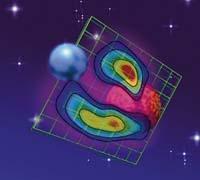For the first time they observe the magnetic field of a star different from the Sun

The journal Nature has published images of the magnetic field of a star that is not the sun. So far, astronomers only knew that other stars had magnetic field thanks to their indirect indications. Finally, the astronomer at the University of Iowa, Bill Peterson, and his team, have obtained live images. "It's a great achievement," according to the Science website.
The magnetic field collected by astronomers in the images is produced by one of the stars of the Algol system. The system is 93 light-years away and consists of two stars. The mass of one is three times greater than that of the Sun and the other a little smaller than that of the Sun. The stars are very close: 9 million kilometers. The magnetic field operator is the smallest star, and although the field is 1000 times larger than that of the Sun, they have needed two networks of telescopes and two radio telescopes to collect the signals generated by the magnetic field.
Analyzing the images, astronomers have seen that this magnetic field is shaped like a giant loop that extends to the north and south poles of the other star. They have observed it for six months and it has not varied throughout that time. In this it does not resemble the Sun, since its magnetic field grows sharply and decreases. Astronomers expect the magnetic fields of stars to be better known by comparing both, and thus being able to foresee magnetic solar storms, for example.





